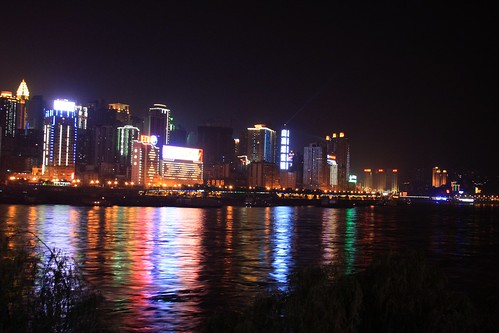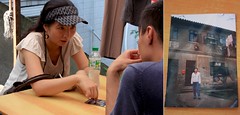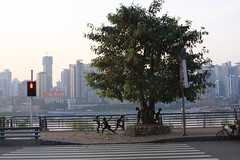
CHONGQING — About a three-hour plane ride west of Shanghai on the Yangtze River there is a booming Chinese city that rarely gets mentioned in the American mass media. Until about ten years ago, many parts of Chongqing were farmlands and rural areas. Today, its cityscape has a density mirroring Chicago’s, and decorative building lights that gently turn the nighttime skyline into a festive showcase of a colorful urban space.
“The city is growing very fast, and my fear is that I won’t be able to recognize it anymore very soon,” said Chongqing native Kim He as she strolled along the banks of the mythic Yangtze River. Kim was a high school classmate of one of my Beijing contacts. Generous with her time and always thoughtful about Chongqing’s traditions and transformations, she offered to take me around her hometown to help me make sense of this rapidly growing city.
There are three main areas in the city, Kim told me. Yu Zhong is the city’s Central Business District, sandwiched between the Yangtze and the Jialing Rivers. South of that is Nan’an, where restaurants serving Chinese food of all regions are tucked inside buildings with worldly facades on the river front. In a one block stretch along the river in Nan’an there are roman columns, cathedral-esque windows, and a square-edged Malibu-style beach house restaurant. And to the north is Jiangbei, where most buildings, including the Holiday Inn where I stayed, did not exist ten years ago.
“So why are you interested in my city?” Kim asked me after she pointed out Chongqing’s unique architectural features. “What have you read about us?”
I am a writer interested in history, I told her, hoping to hear her personal experiences as a 35-year Chongqing resident. We exited a building that has entrances on the top and the bottom to accommodate the city’s hilly geography. The changes must have been breathtaking: most people see social transformations as momentous as Chongqing’s over a generation or half a life time, but Kim has seen those vast changes in only a few years. By the time she finished college, she could barely recognize the city that she knew during high school.
“When I was younger, I remember watching a film called ‘Hua Yan’,” recalled Kim in a mixture of Mandarin and English. Set in Shanghai, the movie attempts to capture the mood of a fast-changing city, where storied neighborhoods rapidly give way to the unfamiliar. “I didn’t relate to the movie at the time,” she continued, “but now I do. I see that in my life in Chongqing now.”
Up until 1997, Chongqing was a part of Sichuan Province, the same province where a devastating earthquake killed almost 70,000 and left millions homeless last May. Now, Chongqing is one of China’s four municipalities—along with Beijing, Shanghai, and Tianjin—that enjoy provincial-level status. The Chongqing municipality is roughly the size of Maine, and it has a population of about 31 million. About five million people reside in the immediate urban area of Chongqing city.
Considered a “second-tier city,” Chongqing is now a priority in the Chinese government’s efforts to further economic development. As the “first-tier cities” of Shanghai and Beijing have achieved international economic importance and prestige, the process is now beginning to trickle down to the second-tier cities such as Chongqing, Nanjing, and Dalian.
The central government has been constructing expressways and other infrastructure to help facilitate second-tier cities’ growth, and foreign investment has been growing as well. According to the U.S. Embassy, almost half of U.S. exports to China in 2006 went to second-tier cities; that year, Chongqing saw a 178 percent jump in American car imports.
“Thirteen of China’s second-tier cities account for eight percent of China’s population but 53 percent of its total imports,” the US Embassy reported (PDF). No wonder Chongqing is now one of the newest Chinese “target cities” for Americans looking for new markets and opportunities.
Chongqing is growing fast, but you can hardly feel it. Unlike Beijing or Shanghai, sidewalk traffic is not shoulder-to-shoulder, and pedestrians rarely push each other. It is a glass, steel and concrete jungle, but the mood reminds me more of Sacramento. In contrast to the indiscriminate neon signs of Shanghai, Chongqing’s street ads seem to flash with more class and style, balancing the wall-to-wall bright ads with milky white lights in between. Located at the confluence of two rivers, Chongqing sometimes feels like an insouciant and pleasant space in the American Mid-West, keeping its distance from the hectic coasts.
“Chongqing people have a very strong sense of identity,” said Kim. “I like to judge a city based on livelihood. People in Chongqing seem to be happier than people in Beijing or Shanghai. Beijingers or Shanghainese might say that they’re happy, but they can never tell you why.”
So what is this “fear” that Kim kept talking about? If Chongqing is developing on terms and at a pace that is different from the first-tier cities, then what is she afraid of? At times, her feelings on Chongqing seem to be as conflicted as the city itself.
“I like a city that grows along with its history,” she explained. “See those buildings over there, where the lights are? In a few years they’ll probably tear them down and build something higher and newer. One day, my husband and I would like to be able to tell our kids where we played—our trees, our river, and our home.” She wanted, in other words, her own layer in history’s narrative.
 Her layer, though, seems to be thinning. Before our chat along the Yangtze, we passed by one of her favorite dessert shops, where we had bing fen liang xia, a popular sweet dish here. There, she pulled out a picture of her own childhood home in Jiangbei. The picture was only taken a few years ago; she stood proudly in front below block characters honoring “the Great Chairman Mao.” She then drew her finger a few inches away from the photo, helping me to picture her front yard.
Her layer, though, seems to be thinning. Before our chat along the Yangtze, we passed by one of her favorite dessert shops, where we had bing fen liang xia, a popular sweet dish here. There, she pulled out a picture of her own childhood home in Jiangbei. The picture was only taken a few years ago; she stood proudly in front below block characters honoring “the Great Chairman Mao.” She then drew her finger a few inches away from the photo, helping me to picture her front yard.“This is where a mulberry tree used to stand,” she said. “I used to play here, and my grandmother was a primary school teacher, so she often invited her students to come and pick the fruit.” This was one of those places that she would have liked to show her future children some day.
Kim’s story stayed in my head all day because it was too difficult to forget. Later that night, just as it was wearing off after dinner, it flashed right back at me as we strolled along the Yangtze River front.
 There, across from the colorful building lights, and directly in front of the restaurants with the eclectic facades, are dozens of trees transplanted from the city’s older areas. And around one of these trees there are two iron metal figures depicting a grandfather playing hide-and-seek with his grandson, along with plaques that read “grandfather and grandson” and “childhood memories.”
There, across from the colorful building lights, and directly in front of the restaurants with the eclectic facades, are dozens of trees transplanted from the city’s older areas. And around one of these trees there are two iron metal figures depicting a grandfather playing hide-and-seek with his grandson, along with plaques that read “grandfather and grandson” and “childhood memories.”The trees, figures, and plaques might very well be the only vestiges of Kim’s layer of history.




No comments:
Post a Comment